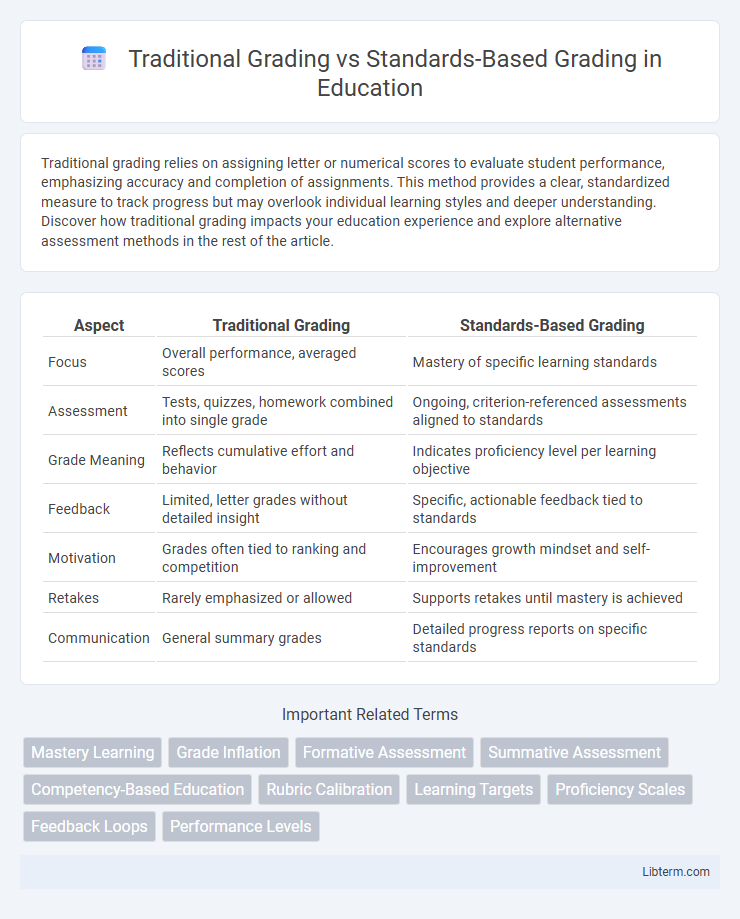Traditional grading relies on assigning letter or numerical scores to evaluate student performance, emphasizing accuracy and completion of assignments. This method provides a clear, standardized measure to track progress but may overlook individual learning styles and deeper understanding. Discover how traditional grading impacts your education experience and explore alternative assessment methods in the rest of the article.
Table of Comparison
| Aspect | Traditional Grading | Standards-Based Grading |
|---|---|---|
| Focus | Overall performance, averaged scores | Mastery of specific learning standards |
| Assessment | Tests, quizzes, homework combined into single grade | Ongoing, criterion-referenced assessments aligned to standards |
| Grade Meaning | Reflects cumulative effort and behavior | Indicates proficiency level per learning objective |
| Feedback | Limited, letter grades without detailed insight | Specific, actionable feedback tied to standards |
| Motivation | Grades often tied to ranking and competition | Encourages growth mindset and self-improvement |
| Retakes | Rarely emphasized or allowed | Supports retakes until mastery is achieved |
| Communication | General summary grades | Detailed progress reports on specific standards |
Introduction to Grading Systems
Traditional grading assigns letter or percentage scores reflecting overall performance, often combining multiple skills and behaviors into a single grade. Standards-based grading evaluates students' mastery of specific learning objectives, providing targeted feedback on individual competencies. This shift enhances clarity in measuring student progress and promotes personalized learning paths.
Overview of Traditional Grading
Traditional grading assigns letter grades or percentages based on cumulative scores from tests, homework, and class participation, often reflecting a student's overall performance in a course. This method emphasizes compliance, effort, and behavior alongside academic achievement, which can obscure specific learning outcomes. Critics argue it lacks clarity in measuring mastery of individual skills or standards and may not provide targeted feedback for student improvement.
Understanding Standards-Based Grading
Standards-Based Grading emphasizes assessing student learning through mastery of specific skills and knowledge aligned with clear academic standards. This approach provides detailed feedback on individual competencies, allowing students and educators to identify precise areas for improvement, unlike Traditional Grading which often combines behavior, homework completion, and test scores into a single letter grade. By focusing on measurable learning outcomes, Standards-Based Grading promotes targeted instruction and supports personalized student growth.
Key Differences Between Grading Approaches
Traditional grading primarily relies on averaging scores from tests, homework, and participation, often reflecting overall student compliance and effort rather than mastery of content. Standards-Based Grading (SBG) evaluates students against clearly defined learning objectives, providing detailed feedback on specific skills and competencies to highlight areas of strength and needed improvement. Unlike traditional methods, SBG separates academic achievement from behaviors, aiming to give a more accurate measure of student understanding through consistent performance criteria.
Impact on Student Motivation
Traditional grading systems often rely on cumulative point averages that can obscure individual learning progress, potentially discouraging students who struggle early on. Standards-based grading provides clear, specific feedback aligned with learning objectives, fostering a growth mindset and encouraging perseverance. By emphasizing mastery over comparison, standards-based approaches typically enhance student motivation and engagement in the learning process.
Effects on Academic Achievement
Traditional grading often emphasizes cumulative scores and percentages, which may obscure individual student progress and specific learning gaps. Standards-based grading provides detailed feedback aligned with learning objectives, enabling students to focus on mastering skills rather than earning points. Research indicates that standards-based grading fosters improved academic achievement by promoting clarity, consistency, and targeted interventions.
Challenges and Limitations of Traditional Grading
Traditional grading often struggles with accurately reflecting student learning due to its reliance on averaged scores that combine behavior, effort, and achievement into a single letter grade. This system can obscure specific skill gaps and progress, limiting actionable feedback for targeted improvement. Additionally, traditional grading may foster competition rather than mastery, reducing motivation for deep learning and critical thinking.
Benefits and Drawbacks of Standards-Based Grading
Standards-Based Grading (SBG) offers precise insights into student learning by measuring mastery of specific skills and knowledge, promoting targeted instruction and personalized feedback. It reduces ambiguity often found in traditional grading where cumulative scores can mask individual competencies, but SBG may require significant teacher training and changes in reporting systems that challenge implementation. The approach encourages student growth mindset by focusing on progress toward standards rather than averaging performance over time, though some critics argue it may increase assessment frequency and administrative workload.
Transitioning from Traditional to Standards-Based Grading
Transitioning from traditional grading to standards-based grading involves shifting focus from cumulative point totals to mastery of specific learning objectives, which enhances clarity in student performance evaluation. Educators must redesign assessments and grading practices to align with clearly defined standards, ensuring grades reflect students' proficiency rather than effort or participation. Professional development and ongoing collaboration among teachers are crucial to successfully implement this data-driven approach and foster consistent grading policies.
Future Trends in Educational Assessment
Future trends in educational assessment highlight a shift from Traditional Grading, which often relies on cumulative scores, toward Standards-Based Grading that measures student proficiency against specific learning objectives. Emerging technologies and data analytics enable real-time tracking of student progress, enhancing personalized learning pathways and improving assessment accuracy. Schools increasingly adopt competency-based models, emphasizing mastery of skills over time, which aligns with the growing demand for equitable and transparent evaluation systems.
Traditional Grading Infographic

 libterm.com
libterm.com